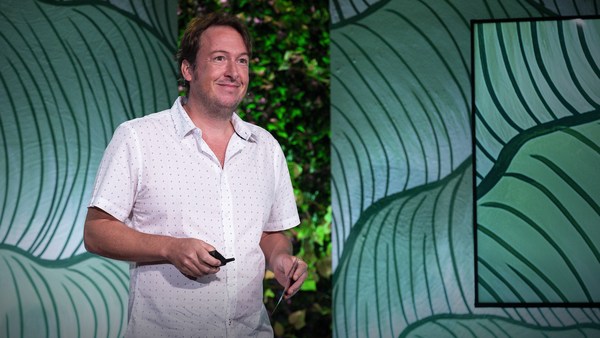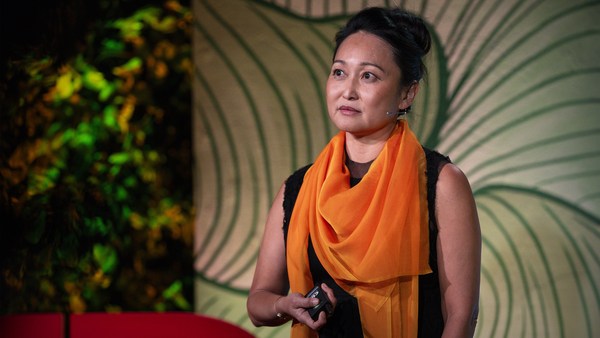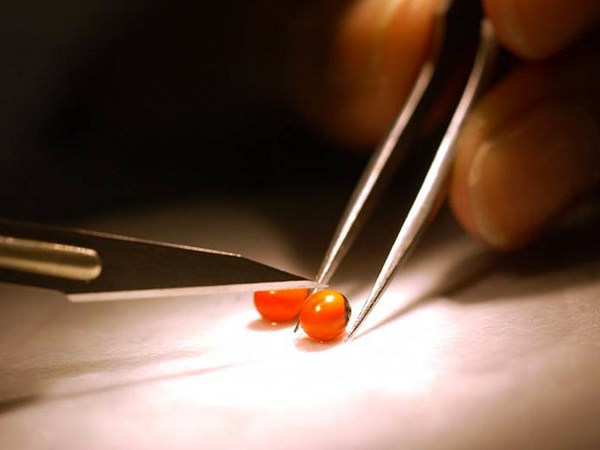So I believe this soybean plant is a prototype for sustainable food production on this planet. Let me show you why I say that.
So on the roots of this soybean plant are nodules. And these nodules do an amazing thing. They harbor millions of bacteria inside the cells of the nodules. And those bacteria are able to capture nitrogen out of the atmosphere and can feed it to this soybean plant.
Now all plants require a source of nitrogen. They need it so they can make DNA, RNA and proteins. But plants can't access the most prevalent form of nitrogen on the planet, the 78 percent of the air that you're currently breathing that is molecular dinitrogen. Only bacteria that possess the enzyme nitrogenase can convert this very inert form of nitrogen, convert it into ammonia, a reactive form of nitrogen that bacteria and plants can use to make their DNA, RNA and proteins. So the bacteria inside the nodules of this soybean plant are fixing nitrogen out of the air, converting it into ammonia, and then feeding that ammonia to this soybean plant. In return, the soybean plant is feeding the bacteria with a source of carbon in the form of sugars derived from photosynthesis in the leaves. This is what we call a mutualistic symbiosis. It's beneficial to the soybean plant, but it's also beneficial to the bacteria inside those nodules.
Now the roots of the soybean plant are doing a second amazing thing. And to see that we have to look under a microscope. The roots are heavily infested with a beneficial fungus called mycorrhizal fungi. And these fungi are heavily colonizing the soil and make a much greater contact with the soil surface than the plant root alone is able to achieve. In so doing, they create a much more efficient platform for the uptake of nutrients, nutrients such as phosphates, nitrates, potassium and water. The fungus isn't only out there in the soil, it's also colonizing the roots of this soybean plant, where it makes these highly branched fungal intrusions into the cells of the root that we call arbuscules. So the fungus is out there in the soil, capturing nutrients from the soil, and it feeds those nutrients to the soybean plant through these arbuscular intrusions. In return, the soybean is feeding the fungus with carbon from photosynthesis. Again, it's a mutualistic symbiosis. So this soybean plant can get almost all of its phosphate and the totality of its nitrogen needs met through these beneficial microbial associations. And that provides a free and sustainable means to support its crop production.
And out in nature, most plants are engaging with one or more of these beneficial microorganisms to help them capture these limiting nutrients from the environment. But in agriculture, it's a really different situation. There, we're applying these nutrients at high concentrations in the form of inorganic fertilizers to support our crop production. And while inorganic fertilizers have underpinned global food security for the last 60 years, they cause significant environmental pollution, they cause significant greenhouse gas emissions, they contribute to a lot of the costs in our crop production. And at the other end of the spectrum, smallholder farmers lack access to those fertilizers and their productivity suffer as a result.
For all of these reasons, myself and my colleagues in the ENSA project are working to eradicate, or at least greatly reduce, our reliance on inorganic fertilizers. To do that, we want to make all of our crop plants, particularly our cereal crops, behave like this soybean plant, able to get their nutrients through these beneficial microbial associations.
Now the fungal symbiosis is not limited to legumes like that soybean. It's actually pretty widespread within the plant kingdom, and it's already present in our cereal crops. However, when we fertilize our fields, the crop doesn’t engage with the fungus. Why are you paying the fungus with carbon if the nutrients are not limiting?
So while soils in natural ecosystems are packed full of a complex network of these mycorrhizal fungi fed by their host plants, our agricultural soils are greatly depleted for these beneficial fungi. If we want to really maximize the utilization of this fungal symbiosis in agriculture, then we need to get our crop plants to engage with the fungus much more proactively, and even when we fertilize our fields. If we can do that, then we can reduce the levels of fertilizers we use, and we'll lose less of those nutrients out into the environment.
So to achieve that, we set about identifying the genetic regulators that control when the plant engages with these beneficial fungi. And we discovered that these proteinaceous regulators are only present when the plant is starved for nutrients. And we were able to rewire that system so that now the plant engages with the fungus much more proactively, and even when the plant is fertilized. In our field trials, we find that these rewired barley plants get 10 times as much fungus inside their roots. That's a lot more fungus in the crop, but it's also a lot more fungus out there in the field. So now we can control when the plant engages with these beneficial fungi.
The next step for us is to test: Does that mean we can lower the fertilizer levels and still maintain good production? I believe this is a first step to really getting that fungal association working for us much more proactively in agriculture, and that's going to be really important, especially for how much phosphates we have to apply to our fields.
But if we're going to really cure our addiction to inorganic fertilizers, we also need the nitrogen-fixing bacterial symbiosis. Now, unfortunately, the nitrogen-fixing symbiosis is limited to legumes like that soybean and their relatives. So we are working on transferring that nitrogen-fixing symbiosis from legumes to our cereal crops. Myself and my colleagues have spent the last 30 years undertaking genetic dissection to try to identify all the genes that, in soybean, allows it to engage with those nitrogen-fixing bacteria. During that time, we've identified many genes that are involved in that process. But surprisingly, we haven't yet identified a single gene that is novel to that soybean plant. In fact, the genes are already present, most of them are already present in our cereal crops.
Let me give you an example. The symbiosis signaling pathway. This is a set of proteins that are expressed on the cells on the surface of that soybean root, that allow the soybean plant to recognize the nitrogen-fixing bacteria out in the soil. When they recognize the bacteria, they oscillate their calcium in the nucleus. This is essentially the cell saying, "I've seen these beneficial bacteria out in the soil. Now turn on the gene expression that's necessary to let those bacteria in." This symbiosis signaling pathway that in the soybean plant allows it to perceive the nitrogen-fixing bacteria, it's already present in our cereal crops. And that's because it's the same signal transduction pathway that allows all plants to recognize mycorrhizal fungi.
What we now understand is that when legumes evolve this capability to engage with nitrogen-fixing bacteria, they didn't invent anything new. They used the pre-existing genetic components associated with engagement with beneficial fungi to also allow engagement with beneficial bacteria. Essentially, the nitrogen-fixing symbiosis is really just a modified form of the mycorrhizal fungal symbiosis with a few tweaks.
And one of the really important tweaks is to link that symbiosis signaling pathway to root organogenesis to make the nodules that are able to accommodate those nitrogen fixing bacteria. But even there, these apparently unique nodule structures are not that novel. They use pre-existing developmental genes that are already present in our cereal crops.
So essentially, nitrogen fixation uses a whole set of pre-existing genetic components, but they re-network them in a novel way to create the apparent novelty of nitrogen fixation. Now from an engineering perspective, it's much easier to re-network a set of preexisting genetic components than it is to build those genetic components from scratch. Now this work is not yet published, but using this knowledge and getting the networking of those pre-existing genetic components right, we have now been able to engineer nodules in non-legumes. Now unfortunately, at the moment those nodules don't get infected with the nitrogen fixing bacteria. That's the step that we're currently working on. However, I believe we are well on track to delivering nitrogen-fixing cereals. And because we're networking pre-existing genetic components, as opposed to having to build those genetic components from scratch, I'm pretty confident that we can deliver those nitrogen-fixing cereals within my career.
Nature has already shown us how to sustainably feed this planet, and it's here in my hand. I believe the next green revolution is going to be the microbial revolution, using beneficial fungi to deliver phosphates and beneficial bacteria to deliver nitrogen, providing a much more sustainable means to support our food production systems and providing technology that's accessible to all of the world's farmers.
Thank you.
(Applause)





